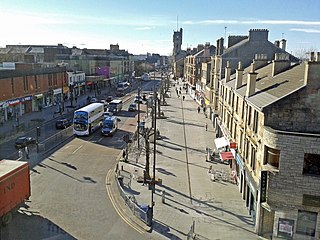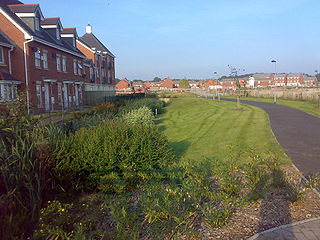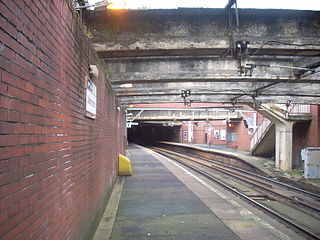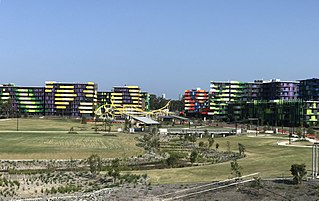
MacDonald, Hugh (2023). Rambles Round Glasgow (annotated). Glasgow: Hephaestion Press. p. 22. ISBN 9781916490932.

Bridgeton is a district to the east of Glasgow city centre. Historically part of Lanarkshire, it is bounded by Glasgow Green to the west, Dalmarnock to the east and south, Calton to the north-west at Abercromby Street/London Road and Broad street to the north-east.

The 2014 Commonwealth Games, officially known as the XX Commonwealth Games and commonly known as Glasgow 2014,, was an international multi-sport event celebrated in the tradition of the Commonwealth Games as governed by the Commonwealth Games Federation (CGF). It took place in Glasgow, Scotland, from 23 July to 3 August 2014.
Dalmarnock is a district in the Scottish city of Glasgow. It is situated east of the city centre, directly north of the River Clyde opposite the town of Rutherglen. It is also bounded by the Glasgow neighbourhoods of Parkhead to the north-east and Bridgeton to the north-west.

Buckshaw Village is a 21st-century residential and industrial area between the towns of Chorley and Leyland in Lancashire, England, developed on the site of the former Royal Ordnance Factory (ROF) Chorley. It had a population of 4,000. It is divided between the civil parishes of Euxton (south) and Whittle-le-Woods in Chorley, with the north western part being in Leyland unparished area in South Ribble district.

Meadowbank Stadium is a multi-purpose sports facility located in the Meadowbank area of Edinburgh, Scotland. Built on the site of the earlier New Meadowbank and Old Meadowbank sports venues, it was originally built to host the 1970 Commonwealth Games. It also hosted the Games in 1986, becoming the first venue to host the Games twice. It is the current home of Scottish League One side F.C. Edinburgh.

Dalmarnock railway station, serving the Dalmarnock area of Glasgow, Scotland, lies on the Argyle Line, two and a quarter miles (3.6 km) southeast of Glasgow Central. The northern ends of the side platforms are within a tunnel. Revamped for the 2014 Commonwealth Games, the station is a 15-minute walk from the Commonwealth Arena and Sir Chris Hoy Velodrome, and Celtic football club's Celtic Park stadium at Parkhead.

The Cuningar Loop is a meander on the River Clyde in Scotland which was converted to a woodland park in the mid-2010s. It lies within the territory of Rutherglen, South Lanarkshire, directly east of the district of Dalmarnock in Glasgow.

Bishopbriggs Academy is a secondary school in the town of Bishopbriggs, Scotland, in the district of East Dunbartonshire. Bishopbriggs Academy is a non-denominational, co-educational, comprehensive school taking pupils from S1 to S6. It is currently one of two secondary schools in Bishopbriggs, along with Turnbull High School at Brackenbrae.

The Glasgow bid for the 2014 Commonwealth Games was the successful bid to host the 2014 Commonwealth Games by the city of Glasgow, Scotland. It beat the Abuja 2014 Commonwealth Games bid to host the games, which will be held over 11 days, with the opening ceremony on 23 July 2014, and the last day of competition and closing ceremony on 3 August 2014.

Barry Buddon Training Area is a Ministry of Defence-owned rifle range and training area in Barry, Angus, Scotland, which runs adjacent to Carnoustie Golf Links and the Dundee - Aberdeen railway Line.

Scotstoun Stadium is an athletics and rugby union stadium in Scotstoun, an area in the West End of Glasgow, Scotland.
The 2010 Commonwealth Games Village was the athletes' residence for the 2010 Commonwealth Games in New Delhi. The village is spread over an area of 63.5 hectares.
The 2010 Commonwealth Games venues were all located in the host city of Delhi.

The Commonwealth Arena and Sir Chris Hoy Velodrome, known for sponsorship reasons as the Emirates Arena, is an indoor arena and velodrome in Dalmarnock, Glasgow, Scotland. Built for the 2014 Commonwealth Games, these venues hosted the badminton and track cycling events. Situated opposite Celtic Park in the East End of Glasgow, the complex is the headquarters of Sportscotland and Scottish Cycling.

Shawfield is an industrial/commercial area of the Royal Burgh of Rutherglen in South Lanarkshire, Scotland, located to the north of the town centre. It is bordered to the east by the River Clyde, to the north by the Glasgow neighbourhood of Oatlands and the adjacent Richmond Park, to the south-west by Glasgow's Polmadie and Toryglen districts, and to the south-east by Rutherglen's historic Main Street and its Burnhill neighbourhood, although it is separated from these southerly areas by the West Coast Main Line railway tracks and the M74 motorway. A road bridge connects Shawfield to the Dalmarnock, Bridgeton and Glasgow Green areas.

Calton is one of the 23 wards of Glasgow City Council. On its creation in 2007 and in 2012 it returned three council members, using the single transferable vote system. For the 2017 Glasgow City Council election, the seats increased to four due to the population having risen by 20% since it was first formed, although the boundaries did not change.

East Village is a housing development in Stratford, East London that was designed and constructed as the Olympic Village of the 2012 Summer Olympics and has been converted for use as a new residential district, complete with independent shops, bars and restaurants. The area was formerly contaminated waste land and industrial buildings to the north of Stratford town centre.
This article lists the Venues of the 2014 Commonwealth Games.

The 2018 Commonwealth Games Athletes Village was an accommodation centre to house all participating athletes, as well as officials and athletic trainers of the 2018 Commonwealth Games. It was located in Southport, Gold Coast.




















